

School Librarian Support - The Daily Cafe. We love the fact that librarians all over the world are taking an active role supporting children and teachers in Daily 5 and CAFE.

Close Reading: 5 Questions to Help Students Analyze Complex Texts. Can technology solve America's literacy problem? Roughly 36 million adults in the United States read English at or below a third-grade level.
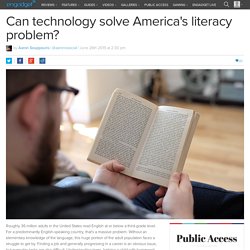
For a predominantly English-speaking country, that's a massive problem. Without an elementary knowledge of the language, this huge portion of the adult population faces a struggle to get by. Finding a job and generally progressing in a career is an obvious issue, but everyday tasks are also difficult. Understanding taxes, helping a child with homework, filling out health care forms or following instructions on medication; these are skills that anyone reading this article takes for granted, but many others toil over daily. We know the situation, but what's the solution? The Future of Literacy. I always knew that I would find my calling among books.
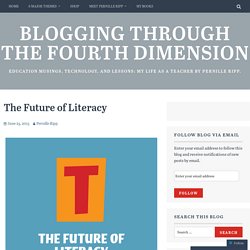
From my childhood bicycle trips straight across town to fill up a bag at the local library, to the constant book in my hands asking for my attention, the nights spent reading under the covers after my lights should have been out. Books seem like they have always been a constant in my journey and now, as a literacy teacher, I feel like I have come home. Right now is an exciting time to be doing anything with reading and writing. With new technology bringing the world into our classrooms, amazing books being churned out daily, and the incredible amount of knowledge that exists a few clicks away, it is an exciting time to be a book lover and a literacy teacher at the same time.
It appears that now may just be the very best time to look ahead, to predict what is coming, and to cherish what we have right now. Theme 1: Global Collaboration. Carol Jago sur Twitter : "Invite students to do a rhetorical analysis of a TED talk. It's a genre all its own ... Literacy on Flipboard. From There to Here & Regions of Canada Thinglink. By: Laurel Croza & Matt James This is a Silver Birch Express book that we read this year that led us on a journey through Canada!
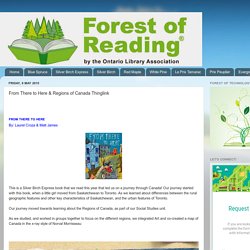
Our journey started with this book, when a little girl moved from Saskatchewan to Toronto. As we learned about differences between the rural geographic features and other key characteristics of Saskatchewan, and the urban features of Toronto. Our journey moved towards learning about the Regions of Canada, as part of our Social Studies unit. As we studied, and worked in groups together to focus on the different regions, we integrated Art and co-created a map of Canada in the x-ray style of Norval Morrisseau: Keep Your Kids Reading All Summer Long! How Visual Thinking Improves Writing. Younger kids typically love to draw and aren’t too worried about the outcomes of their artwork — until they get older.

By the time they’ve learned to read and write, art takes a back burner to academics, primarily because of what most schools prioritize. Over time it becomes harder for kids to think in pictures the way they once did. But what if students were encouraged to think in pictures alongside words? “There’s something about writing that is a link to your brain,” said Marissa Moss, author of the popular children’s book series Amelia’s Notebook.
In the books, Moss takes on the persona of a little girl expressing her ideas about the world and people around her. Balanced Reading & the SAMR. This chart organizes and comprises much of the literacy programming that I did this year.
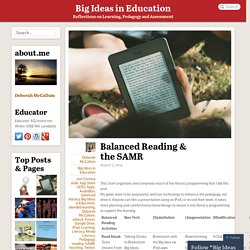
My goals were to be purposeful, and use technology to enhance the pedagogy, not drive it. Anyone can film a presentation using an iPad, or record their work. RED APPLE READING BLOG. Did you know that May is Get Caught Reading Month?
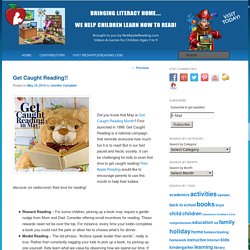
First launched in 1999, Get Caught Reading is a national campaign that reminds everyone how much fun it is to read! But in our fast paced and hectic society, it can be challenging for kids to even find time to get caught reading! Red Apple Reading would like to encourage parents to use this month to help their kiddos discover (or rediscover) their love for reading! Lifelong Learning and Equality of Opportunities for All. A Highlight and Note by Deborah McCallum from Literacy Policies and Practices in Conflict: Reclaiming Classrooms in Networked Times. Facebook algorithms no match for users' own decisions on feeds, study finds. The algorithms used by Facebook to filter news posts have an effect on the information seen by users – but not nearly as much as the choices made by users themselves.
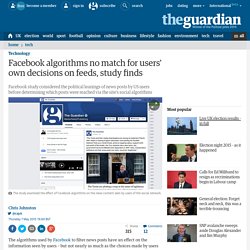
That is the finding of a study published on Thursday titled “Exposure to ideologically diverse news and opinion on Facebook” in Science Express by researchers working for the social network. Eytan Bakshy and Solomon Messing of Facebook, along with Lada Adamic of the University of Michigan, used anonymised data of 10.1m US Facebook users. They considered the news that users posted online for friends – noting whether it was liberal or conservative – and then determined what kind of news, posted by the users’ friends, actually reached users via the site’s social algorithms. N.C. students learn math, literacy, social skills with Scrabble. Skip to main content Browse All Briefs by Topic N.C. students learn math, literacy, social skills with Scrabble Forward to a friend 04/12/2015 | Charlotte Observer (N.C.), The Twelve schools in a North Carolina district have launched Scrabble clubs.
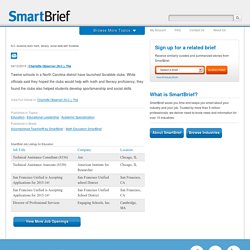
Register Now! UNESCO’s Online Media and Information Literacy Course for Youth. This entry-level online course will provide youth with basic media and information competencies to become critical citizens and agents of change.
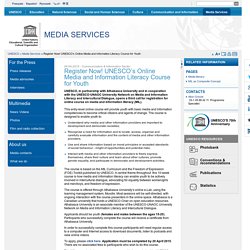
The course is designed to enable youth to: Understand why media and other information providers are important to development and democratic societies; Recognise a need for information and to locate, access, organise and carefully evaluate information and the content of media and other information providers; Use and share information based on moral principles or accepted standards of social behaviour - inlight of opportunities and potential risks; Interact with media and other information providers to freely express themselves, share their culture and learn about other cultures, promote gender equality, and participate in democratic and development activities.
The course is based on the MIL Curriculum and the Freedom of Expression (FOE) Toolkit published by UNESCO. Coolcatteacher. Silvia Tolisano sur Twitter : "Designing New Literacies - Desgining New Literacies. In Mike FIsher and my keynote/workshop last week at the Wildly Excited Conference at the Grand Rapids State University in Michigan, I shared the following blended sketchnote (blended= self-drawn doodles/sketches combined with a photograph). Participants were asked to take a look at the image and use the Visible Thinking Routine I see, I think, I wonder from Project Zero. They shared their thinking in a backchannel in a Today’s Meet room. Before looking at my image annotations and reading the examples/ excerpt of the backchannel below with teachers’ responses, consider going through the exercise yourself. Take a few minutes to intensely look at the image above and follow the thinking routine: I see…, I think…, I wonder… Share your responses in the comment section below, adding your thoughts…sharing and making your thinking visible to others.
How could you use these techniques shown or demonstrated in your own classroom: Collaborative Inquiry: Literacy, SAMR and Tech-Enabled Learning Environments. Earlier this year I began a collaborative teacher inquiry that would set up a technological framework for supporting literacy in the lives of our students, and increasing knowledge. My framework included a blog, website, and twitter accounts: @SCDSBforest and @SCDSBbookclubs, and now also @forestofreading as the organizational structures in cyberspace. A way to organize connections between students and knowledge across diverse communities, environments, cultures, and people. A technology supported learning environment and growing connections between students and staff that would help students to step outside of the micro-cultures that exist within our classrooms, and find their voices and passions.
We used twitter, blogs, iMovie, and held an online book club on Skype between 2 different schools within the same school board, facilitated by @mswift with subsequent google form data. Literacy has the potential to go far beyond book knowledge and basic literacy skills. What is the SAMR? Assessing Text Difficulty for Students. Author(s): Sharon Murphy This summary was created by the What Works: Research into Practice program at the Ontario Ministry of Education This monograph explores three key kinds of knowledge that may help teachers arrive at more informed and defensible judgments about the likelihood of a text’s readability for children: 1. knowledge about the reader’s characteristics and the reading task 2. knowledge about the surface features of a text 3.knowledge about the deeper features of texts and the modalities represented in the text.
Click here to download the document Tags: cultural diversity, Diversified teaching, Language and Literacy, Literacy, readability, Reading, Reading comprehension, Student Success, Teaching and learning, Teaching and learning / pedagogy, Text difficulty, Vocabulary. Join our Forest of Technology: Promote and Enhance Literacy with Tech! Posted 12/14/2014 10:46AM | Last Commented 12/14/2014 10:46AM. Reflections on Literacy Programming.
After having been a Teacher-Librarian, AQ Instructor, and starting a family for the past 10 years, it is a learning curve being back in the classroom. Working with students and teaching students all day in some capacity, will never be quite the same as being responsible for your own classroom of students. Are You Network Literate? By Eric Hellweg | 2:00 PM March 1, 2012 Reid Hoffman, co-founder and executive chair of LinkedIn and investor in Facebook, Zynga, and Groupon, sees networks. “It’s not like The Sixth Sense,” he told the crowd at TED on Wednesday. Halloween Reading — @AngeReads and @droogmark Adult Books 4 Teens. The Importance of Asking Questions to Promote Higher-Order Competencies. Irving Sigel devoted his life to the importance of asking questions.
He believed, correctly, that the brain responds to questions in ways that we now describe as social, emotional, and cognitive development. Questions create the challenges that make us learn. How to integrate literacy with STEM - The Answer Sheet. This was written by Chris Roe and Ralph Smith. Roe is chief executive officer of the California STEM Learning Network; Smith is managing director of the Campaign for Grade-Level Reading. Deborah McCallum sur Twitter : "An all-time favourite @MorrisLessmore What is your favourite? @MorrisLessmore #reading #literacy #tlchat #libchat.
Apps for Early Literacy - UPDATED.pdf. Literacy with Mrs. McCallum. Literacy is relating to views, attitudes & needs of Students. The Importance of Choice in Fostering Independent Reading. Literacy – the Ultimate Investment for a Sustainable Future. For UNESCO Director-General Irina Bokova, “this unacceptable situation is holding back all efforts to reduce poverty and advance sustainable, human development.” UNESCO’s International Literacy Prizes reward groundbreaking programs that show the central role of literacy in promoting sustainable development, through human rights, gender equality, conflict resolution and cultural diversity.
Literacy Day. My Newest Reflections: 5 Steps for running an effective Inquiry Based Literacy Program. Hamilton M.S. sur Twitter : 8th graders aren't too old for carpet time...everyone loves being read to. #literacy #HISD #GreatAllOver #AHMS. Think Your Middle Schoolers Can't Read Academic Journals? Think Again. A New Mindset About Complex Text. 5 Strategies for Integrating Edtech. Boys Literacy Initiatives: Time to Evolve with ... The Collective Consciousness of the Classroom, Complex Learning Environments and Literacy. Metacognition, Common Reading Difficulties & Edtech. Metacognition, Common Reading Difficulties & Edtech. Phonics and Word Recognition Instruction in Early Reading Programs: Guidelines for Accessibility. Schools.alcdsb.on.ca/mart/Curriculum Information/Components of a Balanced Literacy Program.pdf. MyBrainshark - Add your voice to presentations, share online, and track viewing.
New Media Literacies — Learning in a Participatory Culture. Edutopia-whitman-assessment-tictactoe. Interactive Story Books online. Blended Literacies. Visual Literacies. Digital Literacy. Writing & Annotating. Writing. Literacy. Guide_Lit_456_Vol_1_Pt1_Junior_Learner.pdf. Literacy and Numeracy Secretariat.